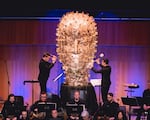
Andy Akiho
Courtesy of Oregon Symphony
Don’t ask Andy Akiho what to think, feel or expect when he takes the stage this weekend.
“I want the listeners to take away their own experience. You can’t try to force a particular feeling or a way to interpret his pieces or my music,” says the Grammy-nominated musician and Pulitzer Prize finalist. “I want everybody to create their own narrative and not try to force anything on them. I believe it’s a personal experience for each audience member.”
When Akiho says “his pieces,” he’s referring to the towering creations of Japanese-American artist Jun Kaneko, whose ceramic sculptures include a stone obelisk-like pillar and larger-than-life stylized heads colored with stripes and swirls that seem to stare past one another
Related: Jun Kaneko’s works spur ‘freedom of thinking’ amid Japanese garden’s tranquility
Earlier this year, the sculptor hosted an exhibition at the Portland Japanese Garden titled “Garden of Resonance: The Art of Jun Kaneko.”
This weekend, some of Kaneko’s other ceramic structures will take center stage at the Arlene Schnitzer Concert Hall in downtown Portland — where they’ll be used as musical instruments.
Saturday through Monday, Akiho will pay tribute to Kaneko’s decadeslong career with the West Coast premiere of “Sculptures,” the percussionist’s recent nine-track record was made using Kaneko’s creations and co-commissioned by the Oregon Symphony. The program will also feature performances of Tchaikovsky’s Symphony No. 6, “Pathétique,” as well as Dvořák’s “Othello Overture” by the symphony.
Akiho sat down with OPB’s Prakruti Bhatt to talk about “Sculptures,” about his collaboration with Jun Kaneko, and about what’s next for the Oregon Symphony’s composer-in-residence.
Below are excerpts from the interview, edited for clarity and length:
Prakruti Bhatt: How did this collaboration with Jun Kaneko come about?
Andy Akiho: It started with a call from the Omaha Symphony, and they asked me to meet Jun Kaneko. I got really familiar with the art and went out to Omaha a lot, and then started on a piece inspired by his work. Then it evolved into me banging on his sculptures.
Bhatt: Kaneko is notorious for leaving his work untitled to challenge the “freedom of thinking,” to allow viewers to form their own interpretation. How do you define his work?
Akiho: The emotions I get from Kaneko’s work, I can’t even describe it. It’s almost spiritual and it is breathtaking without trying too hard, and I’m captivated by it. The simplicity of it too. The scale of it and the colors and the energy it brings — it’s just extremely inspiring for me.
Bhatt: Kaneko mostly keeps his work untitled. How did you go about titling the tracks in “Sculptures?” Did Kaneko have a say in it?
Akiho: I wanted to put the different pieces of the suite into words without calling everything “Untitled,” because I wanted it to be the composite of a lot of the pieces within that medium that inspired it. So “Translucent” is really responding to the glass. But some of [Kaneko’s] glassworks do have titles, too, like “Parallel Sound.”
I wanted to give it a feeling of how I described the pieces, whether it’s “Petroglyph” — they remind me of petroglyphs a little bit. ... “In that space, at that time” was originally called “Dangos,” which means dumplings. And I wanted to change that to “in that space, at that time,” which is a Jun Kaneko quote when he is describing [the musical track] “Ma” and the space between and the energy he wants his sculptures to give. He says he wants the sculptures to shake the air around them, and I talked about it in “in that space, at that time.”

The Omaha Symphony performs Andy Akiho's "Sculptures" at the Holland Performing Arts Center in March 2023.
Courtesy of Oregon Symphony
Bhatt: As you mentioned, in the track “Ma” Kaneko says, “I want my sculptures to shake the air around them.” And the music does exactly that, with you as the catalyst. How did you approach this process, not just with the sculptures but with the orchestra as well?
Akiho: With the orchestra, I approached it very abstract — in the subconscious feeling I get when I see his works. I don’t want to overthink it. I just want to organically create music from the heart, just from feeling his sculptures. Literally feeling the vibrations, visually, and the energy that these sculptures give me. I mean, I lived with these [sculptures] for several hours, months at a time. Sometimes I would be in the warehouses with these sculptures at 3 or 4 in the morning. So, the energy it brought me there and then, starting to strike them a little bit and getting the feel for them, inspired the orchestral movements as well.
Bhatt: Were there any challenges?
Akiho: One of the challenges of writing this piece was limiting myself, to make sure that I didn’t try to say too much, because I think Jun has an amazing way of saying so much with so little. I think the scope of what he does with that is very inspiring, and I strive to go towards that more as a composer. I might not have reached that goal with this piece, but I believe that his influence has affected my compositions for the rest of my life.
Bhatt: You are the Oregon Symhony’s composer-in-residence. What’s next?
Akiho: The next piece that we’re collaborating on is actually going to be premiered at the Sun Valley Music Festival. The Oregon Symphony is also a part of the consortium. That’s a cello concerto for Jeffrey Zeigler. And that’d be for the 2024-25 season.
